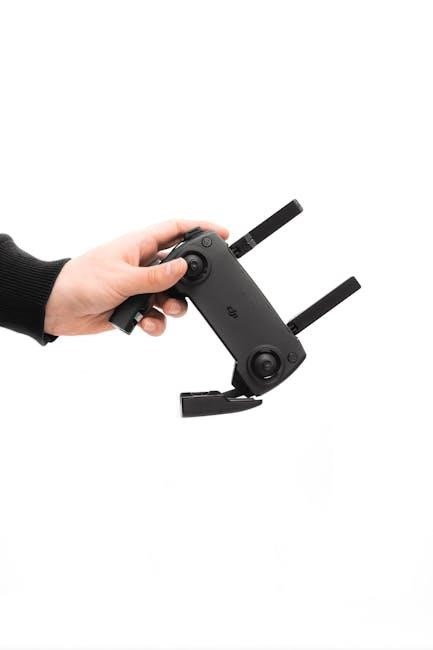The Honeywell DC2500 User Manual provides a comprehensive guide for installing, configuring, and operating the controller. Designed for ease of use, it ensures safe and effective operation.
1.1 Overview of the Honeywell DC2500 Controller
The Honeywell DC2500 is a microprocessor-based, stand-alone controller designed for precision control in various industrial applications. With a compact 1/4 DIN size, it offers advanced features like multi-language support and intuitive operation. Ideal for regulating temperature and process variables, it serves industries such as heating, cooling, metalworking, food, and pharmaceuticals. The controller combines functionality with simplicity, making it a versatile solution for modern industrial needs while ensuring ease of use and reliability.
1.2 Purpose of the User Manual
The Honeywell DC2500 User Manual is a comprehensive guide designed to assist users in understanding, installing, configuring, and operating the controller effectively. It provides detailed instructions for safe and optimal use, ensuring compliance with safety standards and operational best practices. The manual serves as a reliable resource for troubleshooting common issues and performing routine maintenance. By following the manual, users can unlock the full potential of the DC2500, maximizing its performance and extending its lifespan.
1.3 Safety Precautions and Warnings
Adhering to safety guidelines is crucial when working with the Honeywell DC2500. Ensure proper installation, avoiding improper connections that could cause electrical hazards. Use appropriate grounding to prevent shock or damage. Keep the controller away from extreme temperatures, moisture, and corrosive environments. Follow industry standards for electrical safety and comply with local regulations. Failure to observe these precautions may result in equipment damage, void the warranty, or pose risks to user safety. Always refer to the manual for specific warnings and guidelines.
Product Specifications
The Honeywell DC2500 is a microprocessor-based, 1/4 DIN universal digital controller designed for regulating temperature and process variables across various industrial applications.
2.1 Technical Specifications of the DC2500
The Honeywell DC2500 features a 1/4 DIN design, supporting universal input types including thermocouples, RTDs, and voltage/current signals. It offers high accuracy with a 4-digit LED display. The controller supports multiple control modes, including PID, on/off, and ramp soak. With a robust construction, it operates under 90 to 250Vac or 24Vac/dc power, ensuring versatility in industrial environments. The DC2500 also integrates Modbus RTU and TCP/IP communications for seamless system connectivity and advanced monitoring capabilities.
2.2 Operating Limits and Environmental Conditions
The Honeywell DC2500 operates within a temperature range of 32°F to 122°F (0°C to 50°C) and up to 80% non-condensing humidity. It requires a power supply of 90 to 250Vac or 24Vac/dc, ensuring compatibility with various industrial settings. The controller is designed for mounting in pollution degree 2 environments. Storage conditions allow for temperatures between -40°C and 85°C, making it durable in diverse environments. Adherence to these limits ensures optimal performance and longevity of the device, as specified in the user manual.
2.3 Compatibility with Other Honeywell Products
The Honeywell DC2500 is designed to integrate seamlessly with other Honeywell systems, such as PlantScape and Experion PKS, ensuring enhanced functionality and control. It supports Modbus RTU and TCP/IP protocols, enabling communication with compatible devices. The controller is part of a unified platform, allowing easy integration with Honeywell’s industrial measurement and control solutions. This compatibility ensures efficient system operation and simplifies expansion or upgrades, making it a versatile choice for industrial applications.
Installation and Setup
The Honeywell DC2500 manual guides users through unpacking, inventory, and proper mounting of the controller. It also details power supply requirements and wiring connections for safe setup.
3.1 Unpacking and Inventory of Components
Begin by carefully unpacking the Honeywell DC2500 controller and its accessories. Inspect for any visible damage and verify all components against the included packing list. Ensure the correct model, such as DC2500 or DC2501, is received. Check for optional features like communication modules or specific output types. Organize components neatly to prevent loss or damage. Conduct a visual inspection for defects and refer to the manual for specific instructions or warnings. Proper organization and inspection are crucial for a smooth installation process.
3.2 Mounting the Controller
Mount the Honeywell DC2500 controller in a suitable location, ensuring easy access and minimal exposure to environmental stressors. The controller is designed as a 1/4 DIN unit, fitting standard panel cutouts. For front mounting, align the controller with the panel opening and secure it using the provided screws. For rear mounting, attach the mounting bracket to the panel and snap the controller into place. Ensure the panel thickness is within the specified range and avoid over-tightening to prevent damage. Proper alignment and secure fastening are essential for reliable operation.
3.3 Power Supply Requirements
The Honeywell DC2500 controller requires a specific power supply to ensure proper operation. For the DC2500 model, use a 90 to 250Vac power supply, while the DC2501 model operates on 24Vac/dc. Ensure the power source matches the controller’s voltage rating to avoid damage. Connect the power supply according to the wiring diagram in the manual, using appropriate gauge wires. Always follow electrical safety guidelines, such as disconnecting power before servicing and verifying voltage levels before startup. Proper power supply installation is critical for reliable performance and longevity of the controller.
3.4 Wiring and Connections
Proper wiring is essential for the Honeywell DC2500 controller’s functionality. Use appropriate gauge wires for power and I/O connections, ensuring they are securely attached to the terminal blocks. Refer to the wiring diagram in the manual for correct connections. Connect the power supply to the designated terminals, and ensure all I/O signals are wired according to the process requirements. Use shielded cables for noise-sensitive applications and verify all connections before applying power; Follow safety guidelines, such as disconnecting power before servicing and grounding the controller properly to prevent damage or malfunction.

Configuration and Programming
The Honeywell DC2500 controller offers straightforward configuration and programming options. Users can set parameters, alarms, and process variables through intuitive menus. Follow the manual for detailed guidance.
4.1 Initial Setup and Configuration
The initial setup of the Honeywell DC2500 involves interpreting the model number and identifying features using Tables I, II, and III. This step ensures proper configuration. Users can select control outputs, alarms, and communication protocols. The controller’s interface allows for easy navigation, with multi-language prompts guiding the process. Configuration can be done via simple keystrokes, enabling users to define process interactions. Refer to the product manual for detailed instructions to ensure accurate setup and optimal performance of the controller in various applications. Proper configuration is key to achieving desired process control outcomes. Follow the manual carefully.
4.2 Setting Up Input/Output Parameters
Setting up input/output parameters on the Honeywell DC2500 involves defining how the controller interacts with external devices. Begin by interpreting the model number to identify input and output types, such as thermocouple, RTD, or voltage inputs, and relay or analog outputs. Use the provided tables to configure these settings accurately. The manual guides users through selecting appropriate parameters for their application, ensuring compatibility and proper functionality. Correct configuration of I/O parameters is essential for precise process control and optimal performance of the controller in industrial environments. Follow the manual for detailed instructions.
4.3 Configuring Alarms and Limits
Configuring alarms and limits on the Honeywell DC2500 involves defining thresholds for process monitoring. Users can set high and low limits for temperature or other variables, with adjustable hysteresis to prevent false triggering. The controller supports multiple alarm types, such as deviation, deviation high, and process high/low alarms. Follow the manual to assign these settings through the menu interface. Proper configuration ensures timely alerts and maintains process safety. Refer to the product manual for detailed step-by-step guidance on setting up alarms and limits effectively.
4.4 Programming the Controller
Programming the Honeywell DC2500 involves configuring its operation using the keypad or external software. The controller supports customizable logic, timers, and arithmetic operations. Multi-language prompts guide users through setup. Advanced features include function block programming for tailored control strategies. Users can define custom algorithms and set communication parameters for integration with other systems. Refer to the manual for detailed instructions on programming techniques and best practices to ensure optimal performance and accuracy in process control applications.

Operation and Control
The Honeywell DC2500 operates via an intuitive interface, enabling precise control of temperature and processes. Its user-friendly design ensures easy monitoring and adjustment of settings for optimal performance.
5.1 Understanding the Controller Interface
The Honeywell DC2500 controller features an intuitive interface designed for easy navigation and operation. The high-resolution display provides clear visibility of process variables, while the keypad offers direct access to menu options. Multi-language support ensures accessibility for global users. The interface includes customizable screens, allowing users to prioritize essential data. Brightness and contrast settings can be adjusted for optimal visibility in various environments. The menu structure is logical, with clear prompts guiding users through configuration and monitoring tasks. This user-friendly design ensures efficient operation and minimal learning curve.
5.2 Navigating Menus and Options
Navigating the Honeywell DC2500 menu is straightforward, with clear hierarchical options. Use the navigation buttons to scroll through menus and select options. The menu structure is consistent, reducing the learning curve. Each menu level is labeled clearly, ensuring easy access to configuration and monitoring functions. The controller’s interface provides visual indicators for active selections, helping users track their position within the menu. This intuitive design allows for efficient navigation, enabling quick access to essential settings and operational controls.
5.3 Adjusting Process Variables
The Honeywell DC2500 allows for precise adjustment of process variables through its intuitive interface. Users can modify setpoints, PID parameters, and output levels using the front-panel buttons or external inputs. The controller supports both manual and automatic adjustments, ensuring accurate control. Clear on-screen prompts guide operators through each step, simplifying the process. Adjustments can be made during operation or in standby mode, depending on the application. Refer to the manual for specific procedures to optimize settings for your process, ensuring stability and performance.
5.4 Monitoring and Controlling Outputs
The Honeywell DC2500 enables real-time monitoring of output statuses and adjustments. Users can view output percentages, alarm statuses, and process values directly on the interface. The controller allows for precise control of outputs, such as turning them on/off or adjusting their levels. Alarm notifications alert operators to deviations, ensuring timely interventions. Remote control via Modbus communication is also supported, enhancing flexibility. Refer to the manual for detailed procedures to monitor and control outputs effectively, ensuring optimal process management and reliability. This feature is essential for maintaining operational efficiency and safety.
Advanced Features
The Honeywell DC2500 offers advanced features like Modbus RTU and Modbus TCP/IP for seamless communication. It also includes customization options and multi-language support for enhanced functionality and accessibility.
6.1 Modbus RTU Serial Communications
The Honeywell DC2500 supports Modbus RTU serial communications, enabling seamless integration with industrial systems. It uses RS-232 or RS-485 interfaces for reliable data transmission. The controller allows configuration of baud rates, parity, and data bits to match system requirements. Modbus RTU enables remote monitoring, control, and data exchange, ensuring efficient communication between devices. This feature is essential for industrial automation, providing a robust and scalable solution for process control applications.
6.2 Modbus TCP/IP Implementation
The Honeywell DC2500 supports Modbus TCP/IP for Ethernet-based communication, enabling remote monitoring and control over TCP/IP networks. This feature allows integration with industrial Ethernet devices, ensuring reliable data exchange. The controller supports standard Ethernet hardware and can be configured via its interface for IP addressing and port settings. Modbus TCP/IP enhances scalability and flexibility, enabling communication across distributed systems. This implementation is ideal for modern industrial automation, providing high-speed and secure data transmission in networked environments.
6.3 Customization Options
The Honeywell DC2500 offers extensive customization options to meet specific application needs. Users can configure input/output parameters, alarms, and process variables to suit their requirements. The controller also supports multi-language interfaces, enhancing usability across diverse regions. Customizable display settings and programmable logic allow for tailored control strategies. These features ensure the DC2500 can be adapted to a wide range of industrial processes, providing flexibility and efficiency in operation.
6.4 Multi-Language Support
The Honeywell DC2500 features multi-language support, enhancing its accessibility for global users. The controller offers prompts in multiple languages, simplifying operation for diverse regions. This feature ensures ease of use across different countries and industries, making it a versatile solution for international applications. Multi-language support is part of Honeywell’s commitment to providing user-friendly products that meet the needs of a global user base, ensuring efficient and intuitive control regardless of language barriers.

Maintenance and Troubleshooting
This section covers routine maintenance, troubleshooting common issues, and understanding error codes to ensure optimal performance of the Honeywell DC2500 controller.
7.1 Routine Maintenance Procedures
Regular maintenance ensures optimal performance of the Honeywell DC2500. Clean the controller’s exterior and internal components to prevent dust buildup. Check all electrical connections for tightness and integrity. Verify that the power supply meets specifications and update firmware periodically. Calibrate sensors and outputs as needed to maintain accuracy. Refer to the manual for detailed procedures and schedules to prevent operational issues and extend the controller’s lifespan. Proper maintenance routines are essential for reliable operation in industrial environments.
7.2 Common Issues and Solutions
Common issues with the Honeywell DC2500 include error codes, communication failures, and sensor inaccuracies. If an error code appears, refer to the manual for its meaning and resolution steps. For communication issues, check Modbus settings and cable connections. Ensure power supply stability to prevent unexpected shutdowns. If output signals are inconsistent, verify I/O configurations and calibration. Regularly updating firmware and checking for loose connections can prevent many operational problems. Always follow troubleshooting guides in the manual for specific solutions.
7.3 Error Codes and Their Meanings
The Honeywell DC2500 displays error codes to indicate specific issues. For example, E01 signifies a communication error, while E02 points to a sensor malfunction. E03 indicates a power supply problem, and E04 suggests a configuration error. Refer to the manual for a full list of codes and their meanings. Addressing these issues promptly ensures optimal performance and prevents downtime. Always consult the troubleshooting section or contact Honeywell support for unresolved problems.
7.4 Resetting the Controller
To reset the Honeywell DC2500 controller, power cycle the device by disconnecting and reconnecting the power supply. This process clears temporary errors and restores default settings. For a factory reset, press and hold the reset button for 10 seconds while power is applied. Note that this will erase all configured settings, requiring reconfiguration. Always back up your settings before performing a factory reset. Refer to the manual for detailed instructions and precautions to ensure a successful reset operation.

Safety and Compliance
The Honeywell DC2500 complies with industry standards, ensuring electrical and environmental safety. Adhere to installation guidelines and safety precautions to maintain compliance and prevent potential hazards.
8.1 Compliance with Industry Standards
The Honeywell DC2500 is designed to meet rigorous industry standards, ensuring reliability and safety. It adheres to electrical and environmental regulations, making it suitable for diverse applications; Compliance with these standards guarantees optimal performance and minimizes risks. The controller is tested to meet safety certifications, ensuring durability and adherence to global industrial norms. By following the guidelines outlined in the manual, users can maintain compliance and ensure the controller operates within specified limits, providing a secure and efficient solution for process control. Proper installation and maintenance further uphold these standards.
8.2 Electrical Safety Considerations
Ensuring electrical safety is crucial when working with the Honeywell DC2500. Proper grounding and adherence to voltage specifications are essential to prevent damage or hazards. Avoid exposing the controller to overvoltage or reverse polarity, as this can cause irreversible damage. Always disconnect power before performing maintenance or repairs. Use appropriate protective equipment and follow local electrical codes. Improper installation or operation can lead to electrical risks, so consulting qualified personnel is recommended. The manual provides detailed guidelines to ensure safe electrical practices and compliance with safety standards.
8.3 Environmental Compliance
The Honeywell DC2500 is designed to meet global environmental regulations, ensuring eco-friendly operation. It complies with RoHS (Restriction of Hazardous Substances) and WEEE (Waste Electrical and Electronic Equipment) directives; Proper disposal of the controller and its components is essential to minimize environmental impact. Users should follow local recycling guidelines for electronic waste. Additionally, the controller’s energy-efficient design helps reduce power consumption, aligning with sustainability goals. Always handle and dispose of the device responsibly to protect the environment and adhere to legal requirements.
Warranty and Support
The Honeywell DC2500 is backed by an 18-month warranty. For assistance, contact Honeywell Support at 1-800-423-9883 or visit their official website for resources and documentation.
9.1 Warranty Information
Honeywell offers an 18-month warranty for the DC2500 controller, covering defects in materials and workmanship. During this period, Honeywell will repair or replace defective items free of charge. Contact your local sales office for specific warranty details and conditions. This ensures reliable performance and customer satisfaction, aligning with Honeywell’s commitment to quality and user trust.
9.2 Contacting Honeywell Support
For technical assistance, contact Honeywell Support at 1-800-423-9883. Faxback service is available at 1-800-525-7439. International users can refer to regional contact details in the manual or visit the Honeywell Solution Support website. Prompt support ensures minimal downtime and optimal performance of your DC2500 controller.
9.3 Available Resources and Documentation
The Honeywell DC2500 User Manual is supported by extensive resources, including product manuals (51-52-25-127 and 51-52-25-118), a Quick Start Guide (51-52-25-124), and online FAQs. Documentation is provided on CD in English. For additional support, visit the Honeywell website or refer to regional contact details. These resources ensure comprehensive understanding and troubleshooting of the DC2500 controller.
The Honeywell DC2500 User Manual provides a comprehensive guide for installing, configuring, and operating the controller. It ensures efficient operation and optimal performance, making it a valuable resource for users.
10.1 Summary of Key Features
The Honeywell DC2500 is a microprocessor-based controller offering advanced features for precise process control. It includes a user-friendly interface, multi-language support, and compatibility with Modbus RTU and TCP/IP communications. The controller is designed for versatility, supporting various applications in industries like pharmaceuticals, food processing, and HVAC systems. Its compact 1/4 DIN size and robust functionality make it an ideal solution for regulating temperature and other process variables. Customizable options and error handling capabilities further enhance its reliability and efficiency in industrial environments.
10.2 Final Tips for Optimal Use
To maximize the performance of your Honeywell DC2500, ensure proper installation and configuration as outlined in the manual. Regularly check and maintain the controller to prevent dust buildup and ensure accurate operation. Always follow safety precautions and adhere to electrical standards. Utilize the multi-language interface for ease of use and refer to the troubleshooting guide for common issues. For advanced customization, explore Modbus communication options. Contact Honeywell support for any technical assistance, and keep the manual handy for quick reference. Proper care ensures longevity and reliability.

Additional Resources
Access the full product manual (51-52-25-127) for detailed instructions. Visit Honeywell’s support website or contact their technical team for further assistance and documentation. Additional guides include the Quick Start Guide and Modbus communication manuals.
11.1 Accessing the Full Product Manual
To access the full Honeywell DC2500 User Manual, visit the official Honeywell website or refer to the provided resources. The manual (part number 51-52-25-127) is available for download in PDF format, offering detailed installation, configuration, and troubleshooting guides. It includes technical specifications, safety precautions, and advanced features. For convenience, the manual can also be accessed through Honeywell’s customer support portal. Ensure to use the correct document number when searching for the manual online to avoid confusion with similar models. This resource is essential for optimal use of the DC2500 controller.
11.2 Online Support and FAQs
Honeywell offers extensive online support and FAQs for the DC2500 controller. Visit the official Honeywell website for access to troubleshooting guides, technical documentation, and user forums. The FAQs section addresses common issues, installation tips, and software updates. Additionally, Honeywell provides 24/7 customer support through phone, email, or live chat. For specific queries, refer to the support section of the Honeywell website or contact their dedicated technical team. These resources ensure quick resolution of any challenges during installation or operation.
